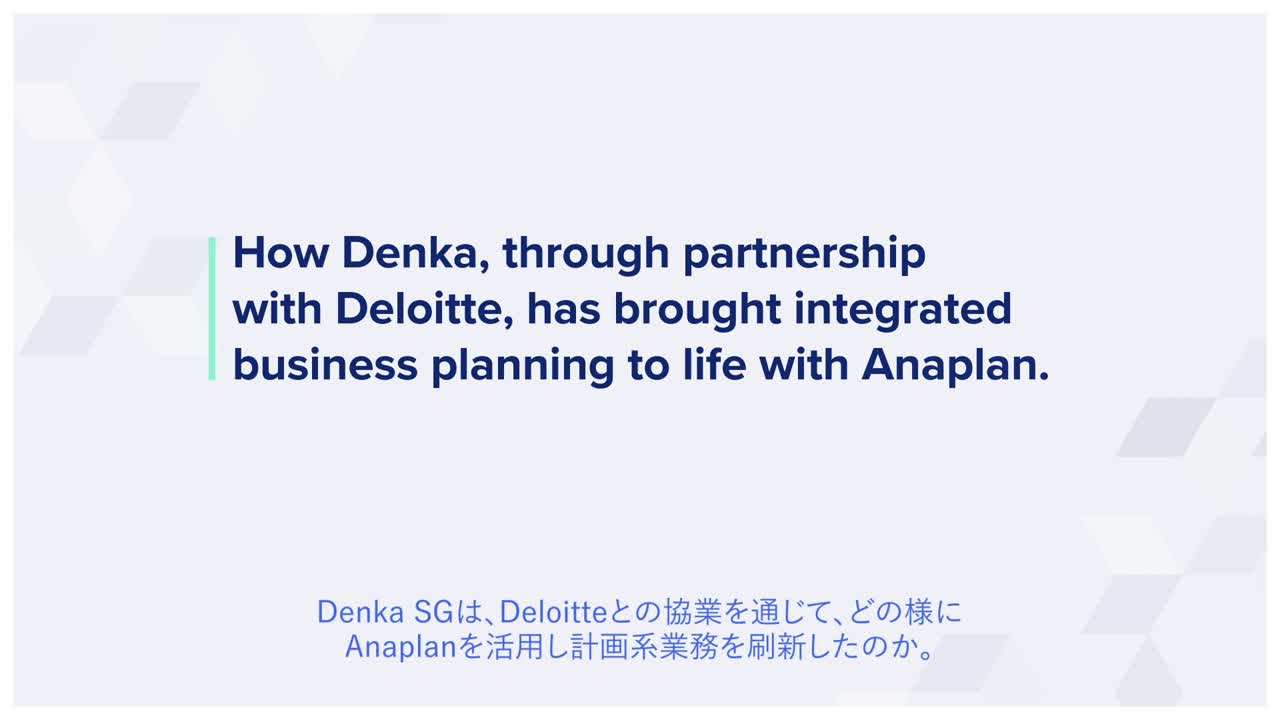Tokyo-based global chemicals company Denka set out to visualize and synchronize its end-to-end supply chain planning process. A new solution, built on the Anaplan platform, connects demand planning, inventory planning, production planning, and profit and loss (P&L) simulation. As a result, Denka has achieved greater business collaboration across multiple sites, agility in decision-making, and overall corporate profitability.
Anaplan … has resulted in, and will continue to result in, important improvements to our operations.Kazuya Tokumoto, Managing Director
Faster
business decision-making because plans across the end-to-end supply chain are integrated and recalculated on the fly.
Automated
reporting with drill-down of variance analysis of product and grade helps identify the root cause of variances.
Improved
collaboration, with multiple operations and functions sharing the same data source for planning.
How Denka, through partnership with Deloitte, had brought integrated business planning to life with Anaplan.
Hi. Today we’ll explore our successful Integrated Business Planning project at the Denka Seraya Plant.
Our ultimate goal is to establish an autonomous supply network that has minimal human interaction by leveraging cutting-edge digital technology. This will be achieved through the following steps:
(1) Achieving a visualization of our end-to-end supply chain.
(2) Creating greater business collaboration with partners.
(3) Optimizing our transportation network and inventory.
(4) Using AI to help predict future events.
And finally, establish an automated operations driving mechanism that enables autonomous decision-making without human intervention.
As a first step, we’re focusing on planning operations — achieving insight into our supply chain. We realized synchronized planning and fulfillment is vital here. We needed extensive visibility into the supply chain and to balance supply and demand in real time to make better strategic decisions.
So how do we achieve synchronized planning and fulfillment? We’ve introduced an integrated business planning process consisting of four areas:
(1) Demand Planning to clarify how much demand we have from each customer;
(2) Inventory Planning to find which product or grade inventory should be set up;
(3) Production Planning to discover what should be produced in what order; and finally
(4) P&L simulation to see how much profit could be achieved when the plan is changed.
Then we choose a best-in-class tool to help us: real-time cloud planning platform Anaplan. Anaplan is a connected planning tool that is flexible and secure. It has three key features that help our project:
(1) Access from anywhere: Being cloud-based, we can stay connected anywhere, and on any device to accelerate our business decisions. Even in the event of an emergency such as COVID-19, we can carry out your work from home.
(2) Collaborative planning: The planning data within Anaplan is all connected. For example, if a salesperson changes the Demand Plan, the system automatically suggests a new production plan to meet demand. It then calculates the right amount of raw material required and checks the projected inventory in real time. This means we can do collaborative planning, rather than sequential planning, shortening the overall planning cycle time.
(3) Multi-scenario planning: With all the demand, production, and inventory planning data connected through Anaplan, our planners can see accurate P&L impact. We can use this for scenario planning to maximize profits and slice and dice the data for further customer and profitability analysis.
We’re already reaping the rewards from Anaplan.
(1) Visualized end-to-end planning: All plans across the end-to-end supply chain are integrated and recalculated on the fly, enabling faster decision-making. From demand through procurement, the integrated plan is visible from a birds-eye view to encourage holistic, optimized decisions.
(2) Changing mindsets. By lifting barriers between departments, each planner understands how their own work impacts others’. With newfound perspective, planners can more effectively collaborate across functions and tackle end-to-end issues.
(3) Free from routine work. Planners are free from manually merging data from various sources. Everything is in Anaplan. Instead of spending time on low-impact tasks, planners can refocus their efforts and contribute to more analytical and strategic work.
(4) Accelerated variance analysis. Determining planning accuracy is no longer a complex operation. Automatically generated reports allow drill-down of variance analysis to the product and grade level. Identifying the root cause of variances is faster than ever before.
I’d now like to show you some videos of interviews of our teams telling you the benefits they’ve already seen.
Text: “What are the benefits of implementing Anaplan into your operations?”
Kazuya Tokumoto, Managing Director (speaking Japanese): We started discussing with everyone in charge of our plants, sales, and engineering departments to identify the needs of our system. Then at the designing phase of Anaplan, each department’s data analysis and what the teams should do, what they could not do, whether they wanted to do it but could not do it. All these issues have become clearer.
This made it possible for us to analyze our operations. Then we have realized that we need to run a full check of these operations’ analyses, not just in the areas related to Anaplan, but to the overall operations.
I believe this is all thanks to Anaplan. As such, we can say that Anaplan not only gave us an application system, but it also made us realis important things. That is to say, Anaplan was both an excellent instructor and a great teacher to us.
And the most important point of all, is that Anaplan projects brought out from each staff member, especially younger ones, capabilities, motivation, and out-of-the-box ways of thinking. I believe this has resulted in, and will continue to result in, important improvements to our operations.
Yuki Shintani, Sales Leader (speaking Japanese): It is all about real-time structure of planning operations. We are a manufacturing company, so we purchase raw materials and manufacture products in the manufacturing department. Then we ship these products to sell to our customers overseas.
Before, these operations were managed by each department. Persons in charge created and processed data manually in Excel files. Then we discussed about the data in these files over the phone or by email, so it was like a human chain operation.
But after we deployed Anaplan, these planning operations, these tasks that we used to do with Excel, are all processed in Anaplan. So now everyone can visualize the data simultaneously in real-time.
I believe that we now have a system in which the sales forecast increases, this information can be flawlessly communicated to the manufacturing department and the raw material purchasing department.
Cindy Lee, Group Supply Chain General Manager: Anaplan is a single platform that allows all the functions to work together. It’s like a single source of information for us to have the updated supply and demand situation so that we, any changes, we are able to act quickly to bring the materials on time for the customers.
So that actually streamlined communication because, I mean, streamlined communication is having to do with teams, and having to pick up the phone, whether you actually come to a (unintelligible) in this communication.
So that single database will help us. Every stakeholder will have the latest information to manage the supply and demand situation. Especially our [unintelligible] or the telemarketers is one.
Hui Peng Leang, Head of In-Plant Logistics: We can use anywhere for this Anaplan, even at home. And because this [is] an app, so we can download it phone site. And especially I’m the one to check the MMP. So if MMP is maybe less, I can highlight immediately in the sales side. So this is quite nice for us.
And also we have communication with all the salespersons, because of our sales, most of the sales [are] in China and Europe. So we can get them together, to work off this function and to achieve cost to serve. For reduced order of cost, [to] achieve order operation.



